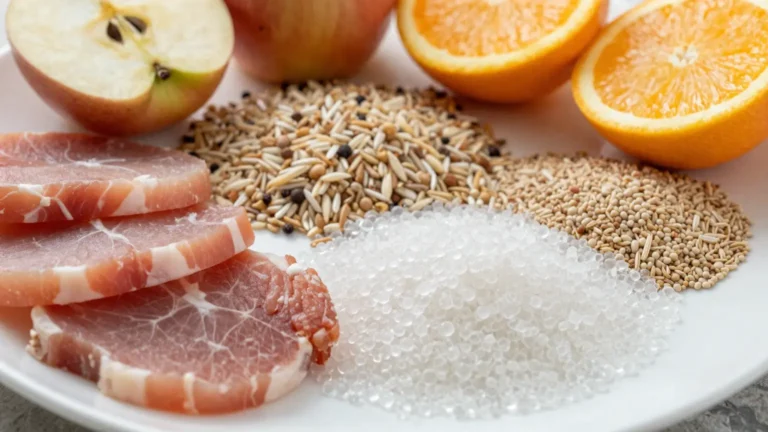Are you considering transitioning to the Carnivore Diet? Embarking on the Carnivore Diet, an eating plan consisting exclusively of animal products, can be challenging but manageable with proper preparation and guidance. Follow this step-by-step guide to minimize side effects and maximize your chances of success.
Steps to Success in Carnivore Transition:

- Educate Yourself
- Plan Your Meals
- Gradually Reduce Carbohydrates
- Increase Fat and Protein Intake
- Monitor Your Electrolytes
- Stay Hydrated
- Expect Adaptation Symptoms
- Track your progress
- Be Patient and Persistent
Educate Yourself
Before starting any new diet, it’s crucial to understand its principles, benefits, and risks. Learn about potential nutrient deficiencies and long-term health implications. The carnivore diet may not be suitable for everyone, and it may take some time to adjust.
Plan Your Meals for Transitioning to the Carnivore Diet
If you feel ready, transition to a full carnivore diet by eating only animal products (meat, fish, eggs, dairy if tolerated). Some people prefer to do this gradually over several weeks or months, while others choose to go cold turkey immediately.
Tips of planning meals on Carnivore diet:
- Create a weekly meal plan focusing on single-ingredient meals like steak, chicken thighs, or pork chops with added fat sources like butter or lard.
- Meal planning helps ensure you stick to your diet and makes grocery shopping easier.
Here is a sample meal plan for gradually transition:
- Week 1-2: Remove processed foods, reduce carb intake by half.
- Week 3-4: Increase fat consumption by choosing fatty cuts of meat and adding healthy fats to meals. Reduce carb intake further (down to about 50g/day).
- Week 5-6: Introduce more animal products if they’re not currently part of your diet. Continue reducing carb intake.
- Week 7-8: Eliminate grains, sugars, and legumes.
- Week 9 onwards: Transition to a full carnivore diet or continue with your preferred level of carbohydrate restriction.
Gradually Reduce Carbohydrates
Abruptly eliminating carbs can cause side effects like fatigue, headaches, and the keto flu. Instead, gradually reduce your carbohydrate intake over time to allow your body to adapt and switch to a high-fat diet.
Here’s a sample meal plan to gradually reduce carbohydrates:
- Week 1-2: Cut out simple sugars (soda, sweets, etc.) and refined grains (white bread, pasta).
- Week 3-4: Limit starchy vegetables (potatoes, corn) and high-sugar fruits (bananas, grapes).
- Week 5 onwards: Further reduce carb intake by limiting or eliminating low-carb vegetables and dairy products.
Increase Fat and Protein Intake
As you decrease carbohydrates, replace those calories with healthy fats and protein from animal sources:
- Add more eggs to your meals.
- Include fatty cuts of meat like ribeye or pork belly.
- Cook with lard, tallow, or butter instead of vegetable oils.
- Incorporate fatty fish like salmon or mackerel into your diet.
Remember that everyone’s body responds differently to dietary changes, so it’s essential to listen to your body and adjust accordingly. It may take time to find the right balance for you.
Monitor Your Electrolytes
Reducing carbohydrates and increasing protein intake can lead to electrolyte imbalances, causing symptoms like fatigue, headaches, or muscle cramps. Ensure you’re maintaining adequate levels of sodium, potassium, magnesium, and calcium by:
- Adding salt liberally to your food.
- Consuming bone broth regularly for collagen and minerals.
- Considering electrolyte supplements if needed.
Stay Hydrated on Carnivore Diet:
On the Carnivore Diet, your beverage choices are quite simple due to its restrictive nature. Here’s a guide on what to drink and how much to consume daily:
- Water : This should be your primary source of hydration on the Carnivore Diet. It’s calorie-free, sugar-free, and helps maintain optimal bodily functions.
- How much: Aim for at least 8 glasses (64 ounces or about 2 liters) per day. Adjust this amount based on your activity level, climate, and individual needs.
- When to drink: Space out your water intake throughout the day. Avoid drinking large amounts with meals as it can dilute stomach acid and impair digestion.
- Tea/coffee : These beverages are generally acceptable on the Carnivore Diet, especially if consumed black (without added sugar or milk). They contain no carbohydrates and have various health benefits due to their antioxidant content.
- How much: Limit yourself to 1-2 cups per day. Excessive consumption can lead to dehydration and other issues.
- When to drink: Have them between meals or after a meal if desired.
- Bone broth : This is a popular beverage among Carnivore Diet followers due to its high collagen content, which supports joint health and gut integrity. It also provides some electrolytes and minerals.
- How much: 1-2 cups per day is sufficient.
- When to drink: You can have bone broth as a snack or alongside your meals.
- Add a pinch of salt or use a low-sodium broth cube in your water to help retain electrolytes.
Which beverages to avoid on the animal-based diet:
- Alcohol
- Fruit juices and smoothies (due to their high sugar content)
- Sodas and other sweetened beverages
- Milk and dairy products (though some people on the Carnivore Diet consume small amounts of hard cheeses)
Hydration tips:
- Drink water even when you’re not thirsty. Dehydration can occur before thirst signals kick in.
- Monitor your urine color. It should be pale yellow; darker colors may indicate dehydration.
- If you exercise intensely or live/work in a hot climate, you’ll need to consume more fluids.
- Consider using an electrolyte supplement if you experience symptoms like fatigue, headaches, or muscle cramps while on the diet, as these can indicate electrolyte imbalances.
Proper hydration is essential while transitioning to the Carnivore Diet. Drink plenty of water throughout the day to support kidney function, combat constipation, and maintain overall health.
Expect Adaptation Symptoms for Transitioning to Carnivore Diet
When transitioning to a carnivore diet, some individuals may experience adaptation symptoms as their body adjusts to the new way of eating. These symptoms typically occur due to changes in macronutrient intake, elimination of certain food groups, or an increase in fat consumption. Here are common adaptation symptoms and strategies to help manage them:
- Fatigue :
- Cause : Your body is adapting to using fat for fuel instead of carbohydrates.
- Management :
- Ensure adequate sleep and rest.
- Stay hydrated by drinking plenty of water.
- Gradually increase your fat intake over time.
- Be patient; fatigue typically improves within a few weeks as your body adapts.
- Brain fog :
- Cause : Your brain is adapting to using ketones for energy instead of glucose.
- Management :
- Stay hydrated and maintain adequate electrolyte intake (sodium, potassium, magnesium).
- Consume sufficient fat to support ketone production.
- Be patient; mental clarity usually improves within a few weeks.
- Bad breath :
- Cause : A byproduct of the body’s transition into ketosis is acetone, which can cause temporary halitosis.
- Management :
- Stay hydrated to help flush out excess acetone.
- Brush your teeth and tongue regularly.
- Use sugar-free gum or mints.
- Consider using a water pick or mouthwash designed for bad breath.
- Digestive discomfort:
- Cause : A sudden change in diet can lead to temporary digestive upset, such as bloating, gas, or constipation.
- Management :
- Gradually increase your fat intake over time.
- Stay hydrated and maintain adequate fiber intake by incorporating low-carb vegetables and fruits into your meals (e.g., leafy greens, avocados, berries).
- Consider using a digestive enzyme supplement to support digestion.
- Nausea or vomiting :
- Cause : A high-fat, low-carb diet can be challenging for some people’s digestive systems initially.
- Management :
- Start with smaller meals and gradually increase portion sizes as your tolerance improves.
- Stay hydrated and avoid drinking large amounts of fluid with your meals.
- Try consuming bone broths or other liquid-based carnivore-friendly beverages to support digestion.
- Headache :
- Cause : The body is adapting to using fat for fuel instead of carbohydrates, which can lead to temporary headaches as blood sugar levels stabilize.
- Management :
- Stay hydrated and maintain adequate electrolyte intake (sodium, potassium, magnesium).
- Consume sufficient fat to support ketone production.
- Be patient; headaches typically improve within a few weeks.
- Leg cramps :
- Cause : Changes in electrolytes, particularly sodium and potassium, can cause muscle cramps, especially in the legs.
- Management :
- Ensure adequate hydration and maintain proper electrolyte balance by consuming salted broths, meat-based stocks, or bone broths.
- Consider using an electrolyte supplement or drinking a cup of herbal tea (e.g., chamomile, peppermint) for its potassium content.
- Skin issues :
- Cause : Transitional periods in nutrition can sometimes affect skin health temporarily.
- Management :
- Stay hydrated and maintain adequate fat intake to support skin moisture and repair.
- Consider incorporating collagen-rich foods into your diet (e.g., bone broths, organ meats) or using a collagen supplement.
If adaptation symptoms persist or worsen, consult with a healthcare provider or registered dietitian to discuss potential underlying issues and appropriate solutions.
Listen to your body:
- Pay attention to how your body responds to the diet, and make adjustments as needed.
- If you experience persistent negative symptoms, it might be a sign that the Carnivore Diet isn’t suitable for you.
Track your progress in the Transitioning to the Carnivore Diet:
To track your progress on a carnivore diet, monitor both physical and mental changes. Here are some recommended methods:
- Track your weight : Weigh yourself regularly to observe any changes in your body weight over time. Keep in mind that muscle is denser than fat, so you might not see significant weight loss even if you’re losing body fat.
- Frequency: Once or twice a week at the same time of day and under similar conditions (e.g., after waking up, before eating).
- Tip: Take measurements around your waist, hips, and chest to track changes in your physique aside from just weight.
- Monitor body composition : Use tools like a skinfold caliper or bioelectrical impedance analysis (BIA) devices to estimate your body fat percentage. This will give you an idea of how much fat you’re losing or gaining over time.
- Frequency: Every 4-6 weeks.
- Tip: Take measurements in the same spot on your body each time for consistency.
- Assess strength and performance : Track your strength and physical performance by performing exercises like push-ups, pull-ups, squats, or other activities you enjoy regularly. This will help you monitor any improvements in muscle and overall fitness.
- Frequency: Every 2-4 weeks.
- Tip: Use a consistent warm-up routine and perform the same number of sets and reps each time for accurate comparison.
- Log your food intake : Keep track of what you’re eating to ensure you’re meeting your nutritional needs, staying within your desired macronutrient ranges, and maintaining consistency in your carnivore diet.
- Frequency: Daily or every other day.
- Tip: Use a food journal or apps to simplify tracking.
- Monitor subjective markers : Pay attention to how you feel physically and mentally throughout the process. This includes:
- Energy levels
- Mood and mental clarity
- Sleep quality
- Digestive comfort
- Skin, hair, and nail health
- Track your bloodwork : Regular blood tests can help monitor your overall health and nutritional status. Consider getting baseline tests before starting the carnivore diet and follow-ups every 3-6 months or as needed.
- Tests to consider: Complete Blood Count (CBC), Comprehensive Metabolic Panel (CMP), lipid profile, Vitamin B12, Folate, Vitamin D, Iron Studies (Iron, TIBC, Ferritin), and Thyroid function tests (TSH, T4, T3).
- Frequency: Every 3-6 months or as recommended by your healthcare provider.
- Take progress photos : Capture visual evidence of your body’s changes over time by taking regular photos in the same pose, lighting, and attire.
- Frequency: Every 2-4 weeks.
- Tip: Choose a consistent backdrop and use natural light for accurate comparisons.
Regularly reviewing and analyzing this data will help you assess your progress on the carnivore diet, make informed adjustments to your eating plan, and celebrate your achievements along the way. It’s essential to be patient and consistent with tracking, as significant changes may take time to become apparent. Always consult with a healthcare provider or registered dietitian if you have concerns about your nutritional status or overall health.
Lastly, consider joining online communities or forums dedicated to carnivore diets to connect with others, share experiences, and gain valuable insights into their progress tracking methods.
Be Patient and Persistent
- Transitioning to the Carnivore Diet takes time, and it’s normal to face challenges or setbacks.
- Stay committed to your goals, monitor your progress, and make adjustments as needed.
- Remember that everyone’s experience is unique, so don’t compare your journey with others’.
More Tips to Make the Transitioning Easier:
- Include Offal : Organ meats like liver, heart, and kidneys are nutrient-dense and can be incorporated into the Carnivore Diet.
- Try New Cuts : Experiment with different cuts of meat to keep meals interesting and varied.
- Cook in Bulk : Prepare large quantities of food at once to save time on future meal preparations.
- Meal Prep Hacks :
- Use a slow cooker or Instant Pot for easy, hands-off cooking.
- Marinate meats before cooking for added flavor.
- Be Flexible : Allow for some flexibility in your diet; even occasional treats won’t derail progress if you maintain overall adherence.
By following these steps and staying committed to your goals, you’ll have a smoother transition into the Carnivore Diet and increase your chances of success.
Before starting any new diet, consult with a healthcare professional or registered dietitian to discuss potential benefits, risks, and appropriate transition strategies tailored to your individual needs.



